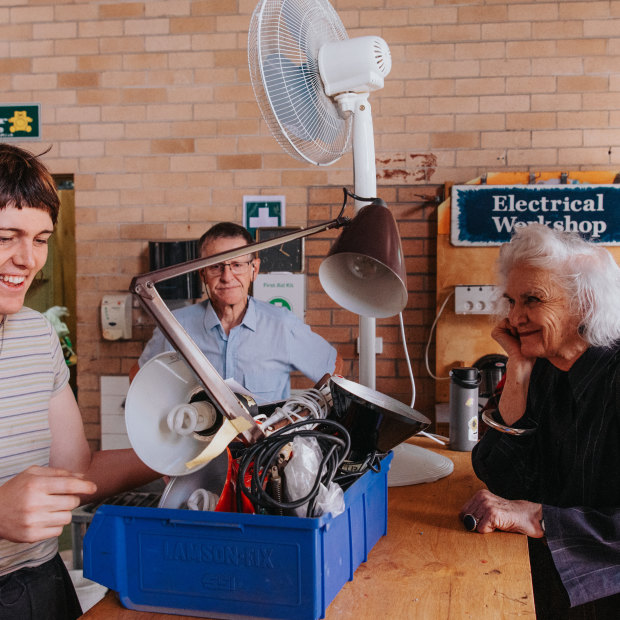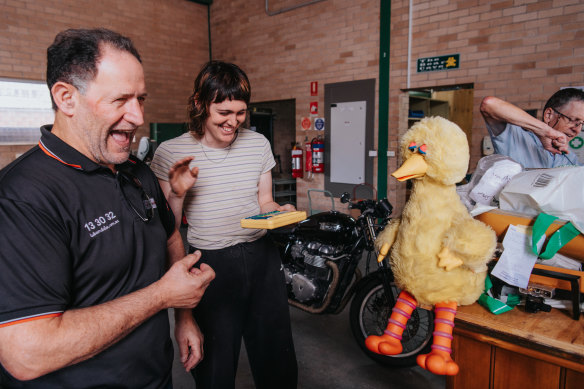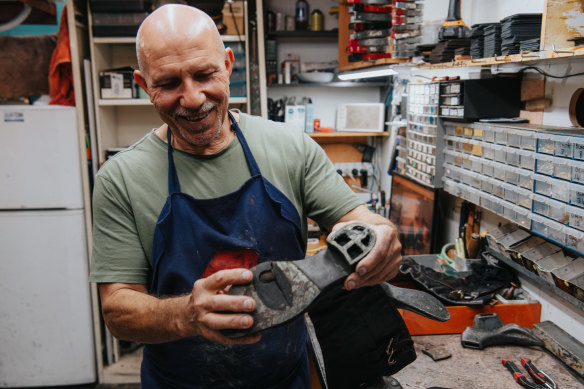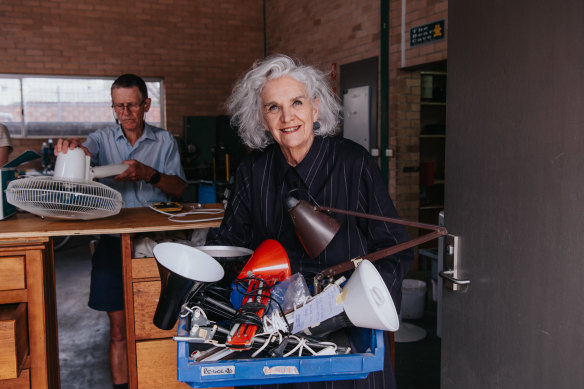This was published 1 year ago
‘I’ve still got my mother-in-law’s Mixmaster’: Inside Sydney’s dying breed of repair shops
By Julie Power

Bower Reuse and Repair Centre lead electrical repairer Othy Willis examines old lamps Liz Williamson brought in to see if they were worth salvaging.Credit: James Brickwood
Being a star is hard work, and Big Bird was tired. After 40 years entertaining John Theore’s children and grandchildren, the Sesame Street toy still sings, his eyes roll, but the mouth is frozen in time. “It is supposed to move up and down,” Theore said.
Theore was one of many desperate people lining up for help from repair whiz Othy Willis at a pop-up repair shop at the Bower Inner West Sustainability Hub in Summer Hill. These repair shops, about 120 in total across Australia, are responding to people who don’t want to add to landfill, or throw out something sentimental.
Around Australia, repair-shop businesses are dying, or shrinking in number. They’re going the way of the tinkers and cobblers, and rapidly becoming history along with the generations of people who – before microchips ran the world – could fix nearly anything.

John Theore asked electrical repair technician Othy Willis to fix Big Bird, his children’s toy, at the Bower Reuse and Repair Centre in Summer Hill. Credit: James Brickwood
The 1858 Sands Directory of Sydney, when the city’s population was about 53,000, listed more than 350 boot- and shoemakers, and shoe shops. Today, with a population of 8.3 million in NSW, the Yellow Pages online lists 138, many doubling as engravers and key shops.
Finding someone who can fix a clock – and make a new part – is also difficult, and the wait can be months. See if you can find a place to repair an old doll. Most have closed.
Some repair shops, though, are going strong, such as the tailors specialising in alterations, and the mobile-phone kiosks in nearly every shopping centre.
And the popularity of automated coffee machines has created a new repair business that runs on coffee fumes.
Here is how five repair shops are getting along.
‘Nobody respects craftsmanship’
Joe Panarello, a third-generation shoemaker and cobbler, will likely be the last in his immediate family. He’s sole weary.
Why? Pointing at commuters wearing thongs, sneakers and rubber-soled shoes, he says: “That’s what to blame.”
His shop TJ Shoe Repairs, in North Sydney’s Greenwood Plaza, is one of two remaining cobbler shops out of six that operated within a kilometre of North Sydney station before the pandemic. The other is a shoe repair/key kiosk.
Working from home in lockdown, people became comfy in runners and lost the habit of wearing harder leather shoes.

Joe Panarello says most people don’t value craftsmanship any more. Credit: James Brickwood
After 45 years in the business he is operating at a loss.
“Before COVID I actually never even had time to have lunch,” he says. Now business is so slow, he watches Netflix after he fixes every shoe.
Panarello’s shop is a microcosm of the economic changes that have affected clothing, textiles and footwear over the past 65 years.
An increased flow of foreign-made, mass-produced goods made shoes cheaper and repairs less attractive.
Since 1960, average spending on clothing and footwear has fallen from 17 per cent of the household budget to 3 per cent in 2023, says the Australian Bureau of Statistics.
Panarello says the public appreciates craftsmanship less than in the past. Customers quibble over costs more. A woman complained about the price but was happy to pay $65 for a weekly shampoo and blow dry at a nearby salon.
“The difference is the hair is on the top of my head,” she told Panarello, “and I have to look good. The shoes are on the bottom of feet, so I don’t care.”
Electrical repair pops up
Belinda Fraser had been everywhere, looking for someone to fix a sleek, black, glass-fronted, one-year-old bar fridge that stopped working – you guessed it – the day after the warranty expired. She’d been told it was too difficult or expensive to fix.
“They say, ‘You can get a new one’,” Fraser said. “I’m the one who has still got my Kenwood food processor that I got as a wedding present because it still works, and my mother-in-law’s Sunbeam Mixmaster.”

Liz Williamson gets old lights repaired at the Bower Reuse and Repair Centre. Credit: James Brickwood
She was typical of customers visiting the Bower who were frustrated with the effort required to repair rather than replace an appliance.
Another customer, Kristina Jaworski, said she had grown up in the era when everything from watches to saucepans was expected to last with some repairs.
She brought along a 50- to 60-year-old electric frying pan that belonged to her mother. It was working again in minutes thanks to “miracle worker” Willis.
As the Bower’s lead electrical repair technician, Willis admitted defeat on a few things. Theore had wanted to get Big Bird repaired so it could move more freely to entertain a grandchild. But the toy was too precious to tinker with.
Theore said: “Repair is a dying sort of thing, and people are happy to pay good money to get things [fixed] that are of a more sentimental value than dollars and cents. You don’t let memories go by getting rid of items.”
‘I don’t profess to know about everything. You just pull it apart and slowly, carefully understand it, rather than being like an expert of everything.’
Repair whiz Othy Willis
Willis has tried to fix most things. “Bread makers. Microwaves. Just everything you can imagine … A lot of coffee machines, they’re really hard ... Lots of speakers. I don’t profess to know about everything. You just pull it apart and slowly, carefully understand it, rather than being, like, an expert of everything.”
In response to demand, the Bower has added weekly workshops, including furniture and bike repair sessions. It is among the oldest of 120 Australian repair cafes that have sprung up to fix rather than toss.
Unwanted and broken electronic products, and those near the end of their useful lives, comprise the world’s fastest-growing waste stream, said Australian Research Council Fellow Professor Leanne Wiseman from Griffith University.
Australia’s 9 million households own about three large household appliances each. Wiseman said the Global E-waste Monitor 2024 report revealed global
e-waste is growing five times faster than recycling.
Wiseman is arguing for Australia to adopt a repairability index, similar to existing energy and water-use labels, to help consumers make better choices and encourage manufacturers to design better products.
“If we had something that could indicate that if you are going to spend $4000 on a fridge, how long it would last, and whether you could get spare parts, tools and information, that’s really going to change people’s buying habits and consumption habits around appliances,” she said.
The Productivity Commission’s Right to Repair report in 2021 supported a repairability label. It said repairs of consumer products had become progressively more difficult (and sometimes impossible).
At the same time, the number of people with repair skills has fallen. And many modern appliances with computer chips cannot be easily repaired.
Wiseman says businesses can learn how to repair products built with computer chips. Cars, for example, have “more code in them than aeroplanes”, she said.
Although Australia no longer manufactures vehicles, a new law that requires manufacturers to share diagnostic data and repair information with all mechanics, not just authorised repairers, has supported mechanics.
Pieces in a jigsaw puzzle
Repairing leadlight – the decorative stained-glass in windows and doors found in homes, churches and cathedrals – is like putting together an old jigsaw puzzle with sharp edges.
It is a dangerous puzzle, carrying the risk of lead poisoning from the dust of the “cames”, the lead used with solder to hold the panes of glass together.
There are few leadlight repair shops, and getting an old window repaired comes with a long wait.
Lawrence Debono, who started Lawrence Leadlights 33 years ago, says most leadlight was installed in Federation homes as a fancy optional extra, and there were several boom periods when they rose in popularity, such as in kitchens in the 1990s.
Debono trained as a glazier but found fixing leadlight windows, doors and skylights – and making new ones – was more rewarding.
“We get compliments every day of the week. Compared to me being a glazier, you don’t get that … We get continuously praised, and that makes me happy.”
Because of the risk of lead poisoning, the Wetherill Park workshop where most of his six craftspeople work is open to the elements on one side. “I can’t run a business unless it is safe,” Debono said.
His company has repaired glass at the State Library of NSW and Our Lady of Lebanon Church, Harris Park, among other places.
Recently Debono was asked to restore an amateur-made leadlight that arrived like a 5000-piece puzzle with 50 bits missing. “It could have been done by a bloke who was totally blind and drunk. But we have to put it back so it looks good,” he said.
Wake up and smell the coffee
One repair sector is riding high on coffee fumes.
The Australian Bureau of Statistics did not keep data on coffee drinking until the late 1950s because tea had been the most popular drink.
And the idea of an industry dedicated to repairing automated domestic coffee machines was unimaginable until 20 years ago.
That’s when Adam Symon’s company Bravo Coffee Machine Repairs in St Peters opened, fixing five machines a week, after the first automated domestic coffee machines entered the market.
Now, the company repairs 28,000 domestic machines a year, plus commercial machines.
When domestic coffee machines from brands such as De’Longhi, Breville and Sunbeam with inbuilt grinders went on sale, that was “when all the magic happened”.
With five workshops around Sydney, the company is training new technicians to add to its existing 30.
“We try to fix, and get these machines out in a five- to six-day turnaround. People do seem to get quite antsy without their coffee machines.”
Symon said it was a job for all the senses. “You have to listen for abnormal noises. You smell, you see it, you taste it,” he said.
The market boomed during the COVID-19 pandemic. Now, about every second household owns a machine. (That’s only a little less than the number of households that owns a dishwasher.)
Symon, a co-owner of Bravo, knows the market is fickle.
The high cost of living means consumers don’t want to buy a new machine if their old one fails. If the price of machines drops too much, broken models will end up in landfill.
Time keeps on slipping
Parker Time in Hunters Hill has rarely advertised its services: there is a 10-month to a one-year wait as it is.
As one of a dwindling number of horologists fixing and restoring watches, clocks and music boxes, most of the work comes from repeat business. It also makes parts.
Damon Parker’s father Carl started the business more than 50 years ago. When the shop’s lead horologist Christopher Soto visits a customer, he will often find one of Carl’s old business cards inside the timepiece.
Everyone has a story about their clock or watch. On cue, repeat customer Lance Chapple arrives, with a yellowing card in his hand. He had sought help from Parker’s dad decades ago and had a question about the value of an old family clock he’d inherited.
“The first thing I do every morning is go downstairs for breakfast and I wind the clock,” he said.
Parker says there’s still a future for repair shops, and he’s recently employed an apprentice.
“If we can judge it by the past, whilst there’s ever going to be heirlooms and pieces that are important to the individual, this skill set will survive.”
Start the day with a summary of the day’s most important and interesting stories, analysis and insights. Sign up for our Morning Edition newsletter.